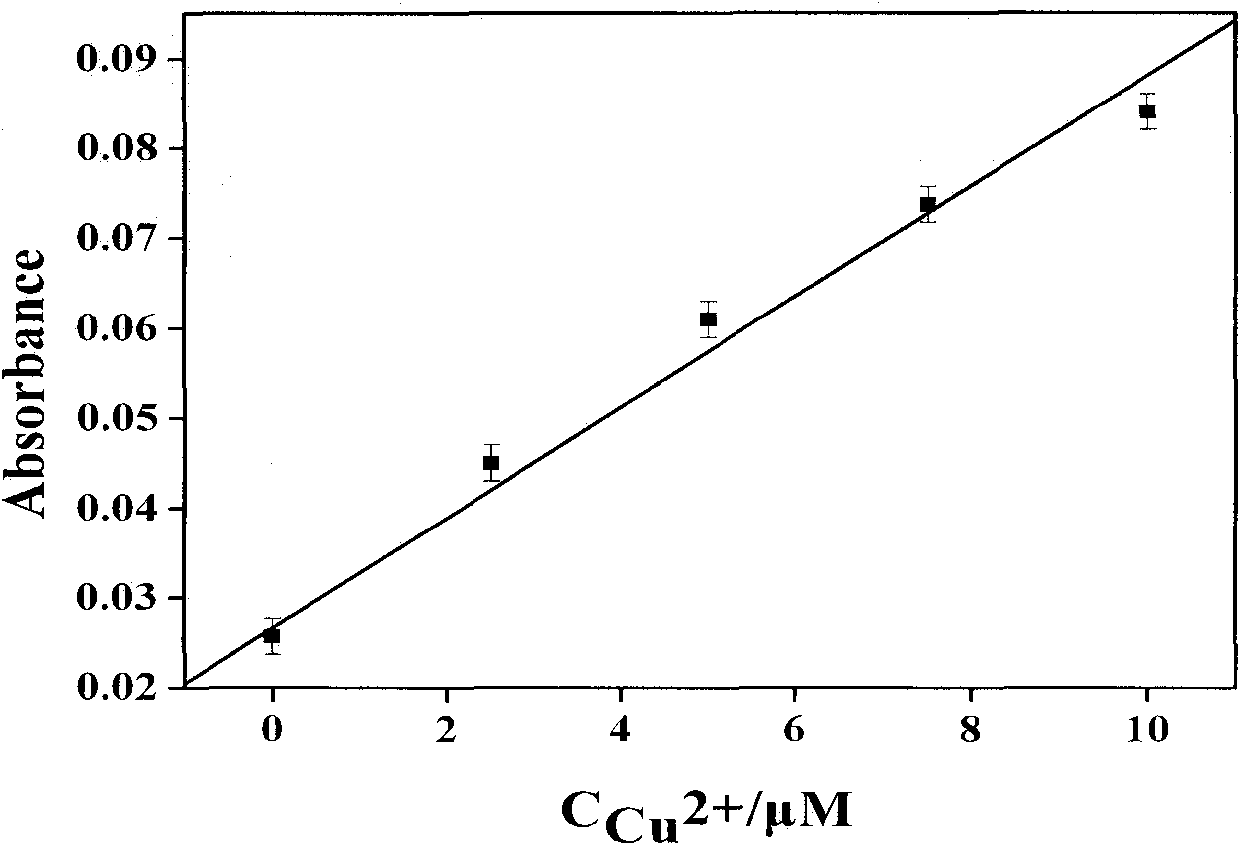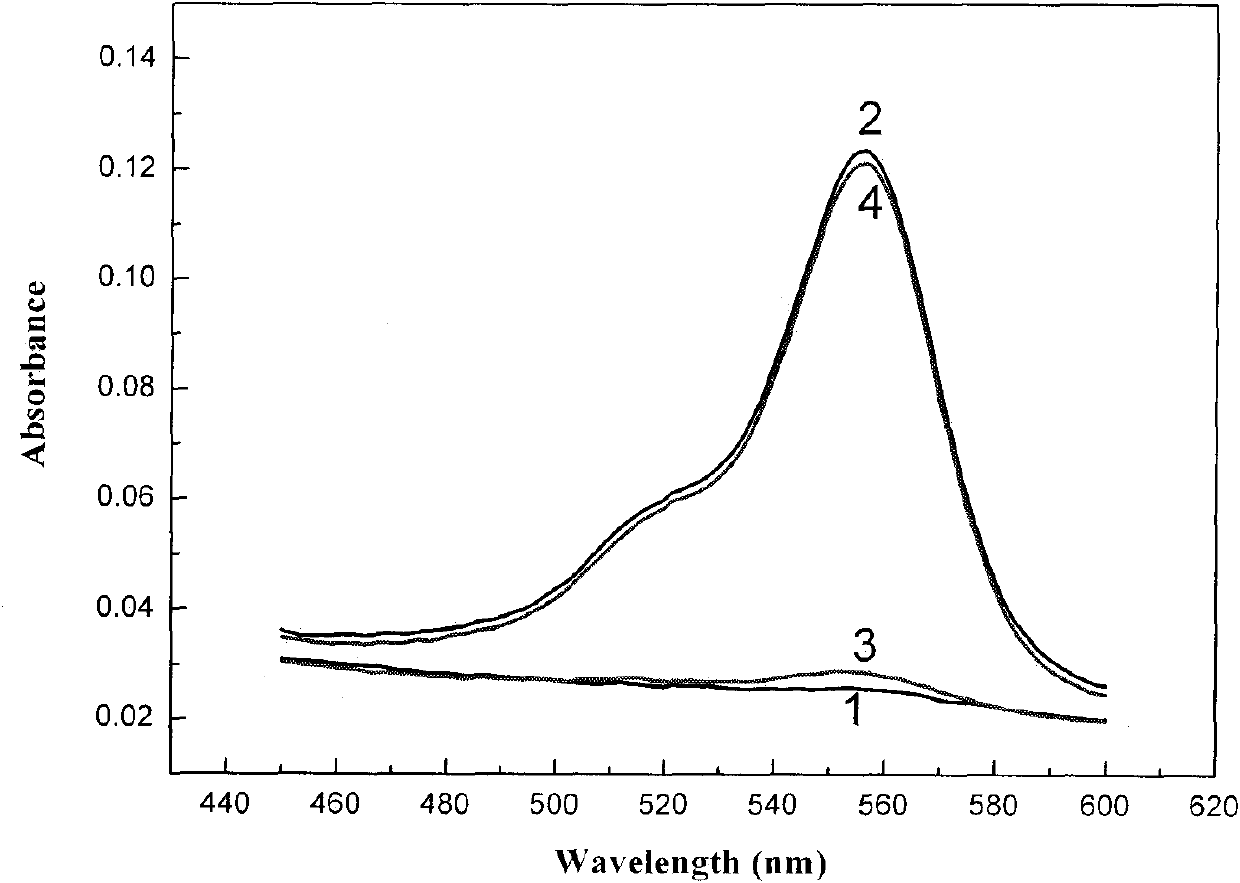Optical probe film and special-purposed organic dye for micro determination of copper ion content in water sample
An optical probe and thin-film technology, applied in organic dyes, organic chemistry, methine/polymethine-based dyes, etc., can solve the problems of cumbersome operation, difficult recycling, and easy introduction of errors, and achieve convenient use, simple production, and low cost. cheap effect
- Summary
- Abstract
- Description
- Claims
- Application Information
AI Technical Summary
Problems solved by technology
Method used
Image
Examples
Embodiment 1
[0033] Embodiment 1, synthetic organic dye rhodamine B hydrazide 4-ethoxy carboxyl salicylaldehyde Schiff base
[0034] Add 1.2g of rhodamine B, 50mL of ethanol and 3mL of 85% hydrazine hydrate in a 100mL round bottom flask, heat to 80°C and reflux for 2 hours, filter out the resulting precipitate (rhodamine B hydrazide), and dry it. Dissolve 0.436g of the obtained solid in 20mL of ethanol, add 0.78g of 4-ethoxycarboxysalicylaldehyde, heat to 80°C and reflux in an oil bath for 6 hours, remove the solvent under reduced pressure, wash the solid with ethanol 3 times, and then dry it. That is, the organic dye rhodamine B hydrazide 4-ethoxy carboxyl salicylaldehyde Schiff base (RBHCOOH).
Embodiment 2
[0035] Embodiment 2, the preparation of optical probe film
[0036] 1) The making of chitosan film:
[0037] Take by weighing chitosan (molecular weight 1.9 * 10) of degree of deacetylation 90%. 5 ) 0.1g in a 25ml round bottom flask, add 10ml 2% HAc and stir at room temperature for one day, add 100μl (37%-40%) formaldehyde the next day, and continue stirring for 2 hours. Then pipette 500 μl of it and spread film on one side of the inner wall of the glass cuvette (or on the glass slide), and place the glass cuvette (or glass slide) under the infrared lamp, the exchange of chitosan and formaldehyde solution The joint reaction lasts for 24 hours. After that, cool the glass cuvette (or glass piece) to room temperature, add 0.1mol / L NaOH to soak for 10 minutes (purpose deprotonation), then wash it with a large amount of deionized water, and dry it under an infrared lamp , to obtain a chitosan film with a thickness of 10 μm.
[0038] 2) Fabrication of RBHCOOCl covalently immobili...
Embodiment 3
[0041] Example 3, Quantitative Determination of Trace Copper Ions in Water Samples Using Optical Probe Films
[0042] In Tris-HCl buffer solution (10 mM, pH=7.0) containing 50% acetonitrile, 2 mL of solutions containing different concentrations of copper ions (0-50 μM) were added to a glass cuvette covered with film. Place it at room temperature (25°C) for 3 to 5 minutes, and then measure it at 556nm by a spectrophotometer (see figure 2 ). First determine the working curve (curve equation y=0.026+0.0062x) through a series of standard samples. From the working curve, it can be seen that the method of the present invention has good linearity at least in the range of 2.5-10 μM copper ion concentration. Water samples such as drinking water and river water are analyzed and tested, and finally it is proved that the optical probe film of the present invention can at least realize quantitative analysis of copper ions in the range of 2.5-10 μM in the water samples.
[0043] Simultan...
PUM
| Property | Measurement | Unit |
|---|---|---|
| Thickness | aaaaa | aaaaa |
Abstract
Description
Claims
Application Information
 Login to View More
Login to View More - R&D
- Intellectual Property
- Life Sciences
- Materials
- Tech Scout
- Unparalleled Data Quality
- Higher Quality Content
- 60% Fewer Hallucinations
Browse by: Latest US Patents, China's latest patents, Technical Efficacy Thesaurus, Application Domain, Technology Topic, Popular Technical Reports.
© 2025 PatSnap. All rights reserved.Legal|Privacy policy|Modern Slavery Act Transparency Statement|Sitemap|About US| Contact US: help@patsnap.com



